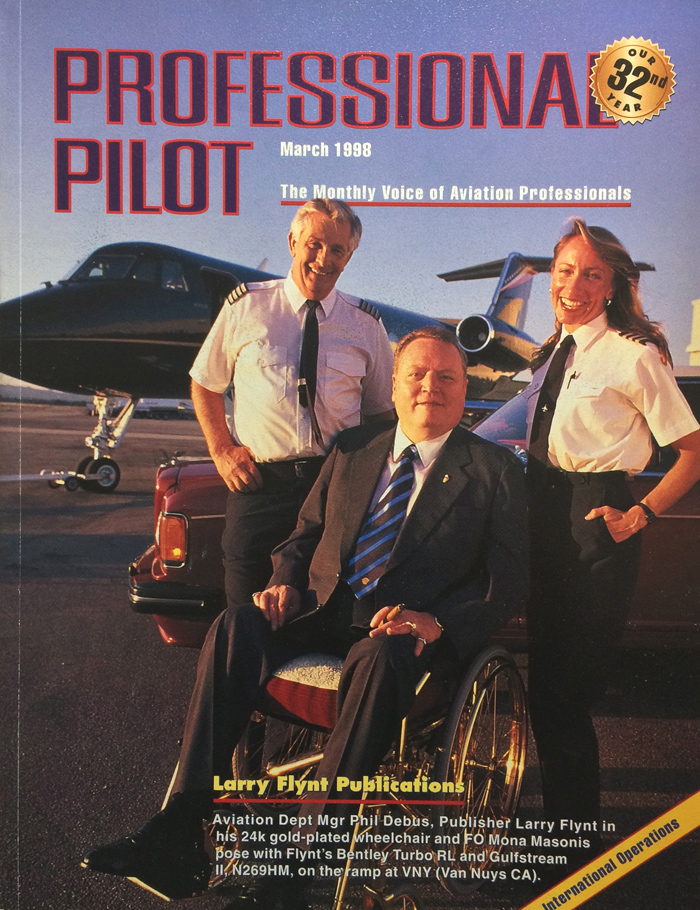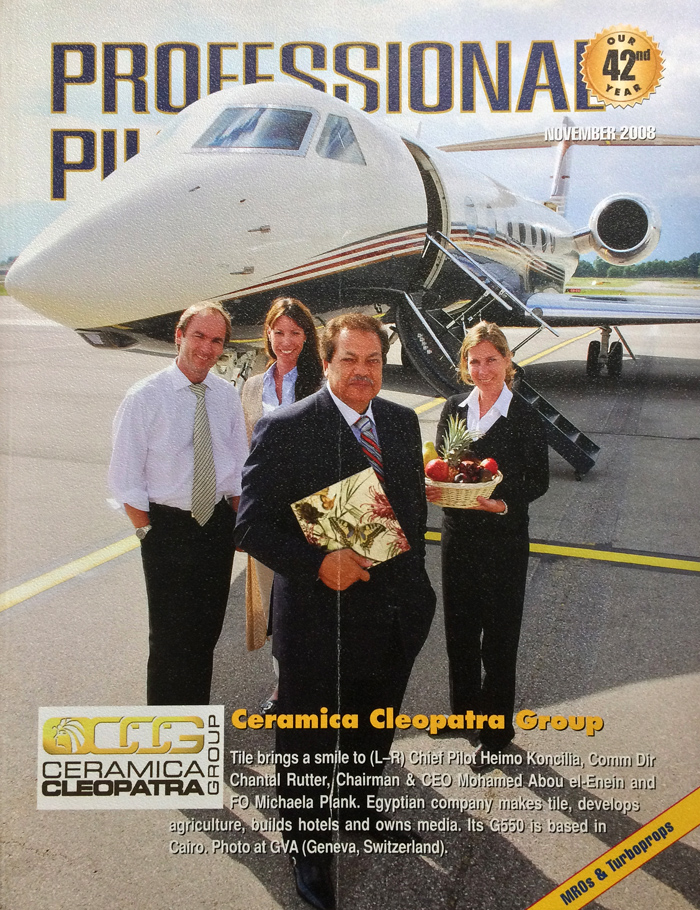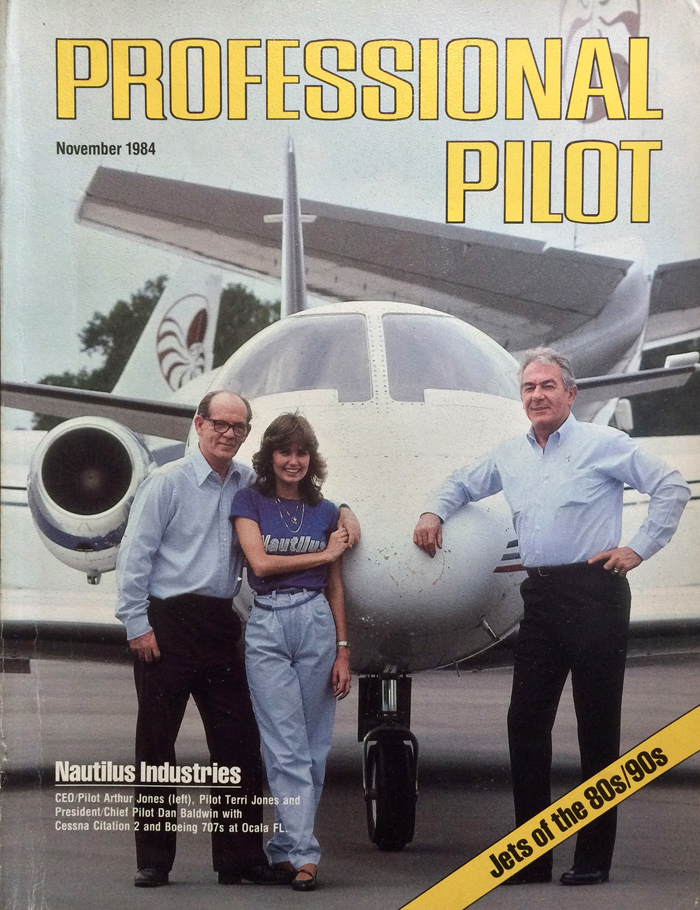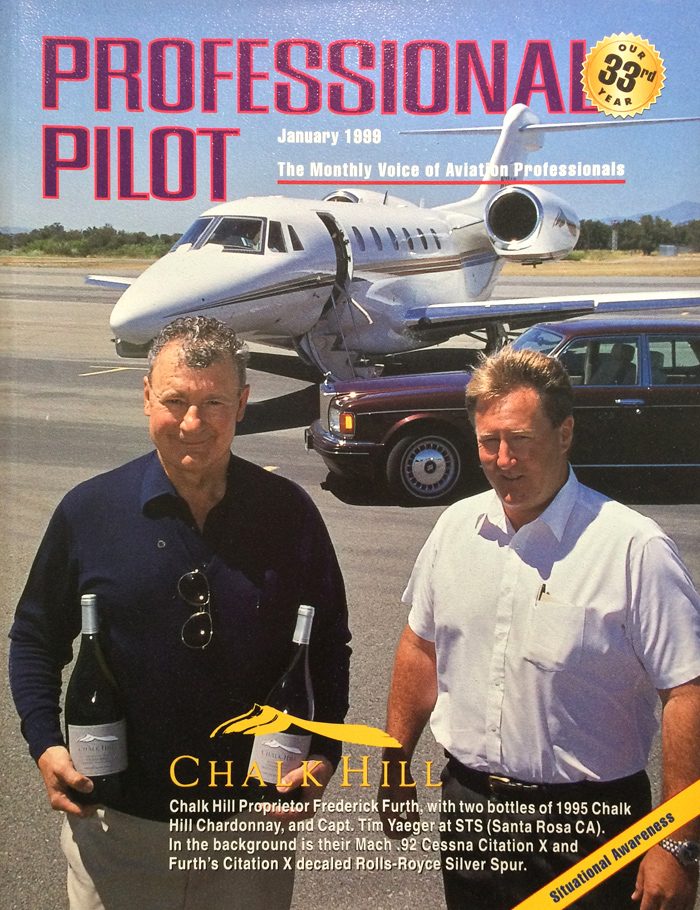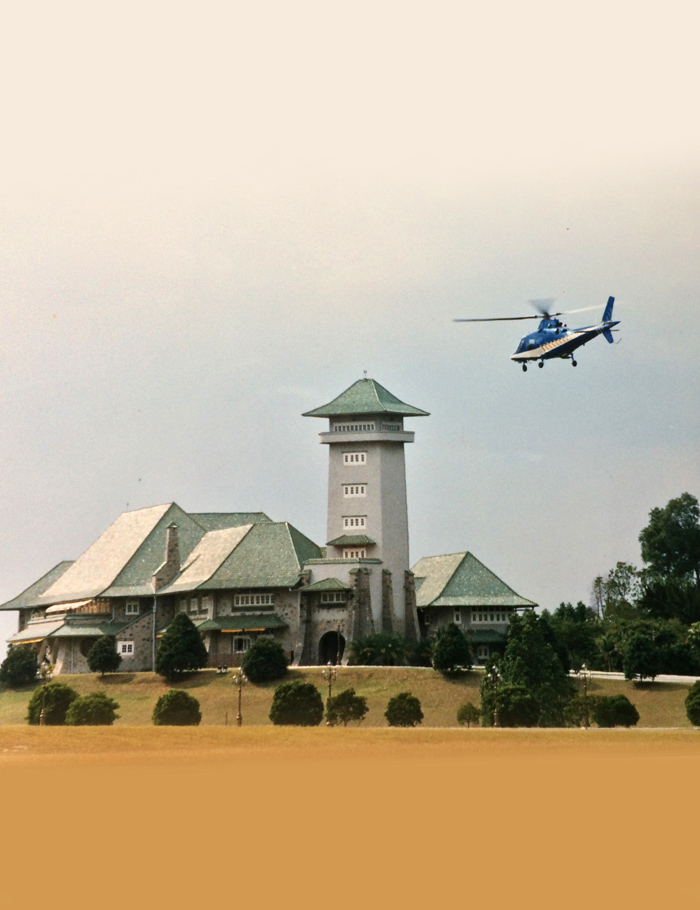Provider of high-end kitchen appliances cooks with Cessna Citation Ultra
By Grant McLaren
Professional Pilot Magazine June 2002
Viking ranges can be found in kitchens of the rich and famous from Beverly Hills to Park Avenue. The list of renowned owners is a virtual who’s who of the culinary, entertainment and business worlds.
Every movie star, celebrity chef and head-of-state cook that uses Viking products becomes another spokesperson for Viking Range Corporation. Although Viking has only been supplying its high-end ranges since 1987, the brand is well known around the globe. Retailing between $2900 and $9000, the Viking range has become the ‘Mercedes’ of kitchen appliances.

Viking range staff with the company’s $8000 VGRC 605 range and Cessna Citation jet in the background
Viking ranges are custom built with over 1000 variations available. In addition to its high-tech industrial-looking professional series ranges, Viking manufactures built-in cooktops, thermal convection ovens, electric warming drawers, ventilation systems, built-in refrigerators, wine coolers, ice machines and dishwashers. The sky’s the limit, in terms of price, for those who long to possess a full Viking kitchen.
For Viking CEO Fred Carl Jr, a former home builder and contractor, the challenge in his 80s range project was in establishing a brand and growing a global business from somewhat-remote Greenwood MS. Building Viking to what it is today, according to Carl, would not have been possible without the benefits of corporate aviation.
“There can be disadvantages in being based in a little out-of-the-way place like Greenwood MS. Corporate aviation, however, makes being in this location OK.” Viking prefers to operate with a lean management team and the operational flexibility of business aviation makes this both practical and possible. “We have maximum convenience when we need to travel and we often go out and come back the same day,” Carl adds. “Remaining productive, while not being reluctant to go somewhere when we need to, is the single most important advantage to having a corporate plane.”
Greenwood is a 1.5 – 2 hr drive from major commercial airports at MEM (Memphis TN) and JAN (Jackson MS). With its Cessna Citation Ultra, however, Viking management and employees can be in either Chicago or New York in about the same time it takes to drive to the nearest commercial airport. Many out and back day trips on the Viking corporate jet would involve 3 – 4 days travel with commercial airline alternatives.
Flight ops Viking operates its 1-aircraft Cessna Citation Ultra flight department out of 6501 ft GWO (Greenwood Muni MS). The company has a small corporate hanger on the field complete with passenger lounge, catering prep area, a workshop and flight planning facilities.
Supporting Viking’s flight operations are Chief Pilot David Edwards, Capt Jim Thigpen and Capt Joe Loyd along with independent maintenance contractor/first officer Neil Dickey.
Edwards (13,500 TT) formerly flew with the Supervalu/Lewis Grocer Division flight department for more than 30 years and began flying with Viking in 1998. Thigpen (TT 16,000 hrs) and Loyd (TT 12,000 hrs) had logged more than 30 and 14 years respectively with the Sara Lee flight department before it was shut down. Mgr Corporate Events Katherine Evans and Travel Coordinator Lyn McCool, are responsible for flight scheduling. Viking flies its 1200 nm range capable Ultra about 650 hours each year.
“We have exactly what we need in the Citation Ultra and it does a very good job for us,” says Edwards. “We’re in the middle of nowhere, so to speak, but our company employees are just a step away from being where they want to be.”
Edwards enjoys the advantages associated in working with a smaller flight department. “This is a family-style business and quite different from working for a very large flight department,” he says. “We have a close relation with management, we can talk directly with the boss and we’re very well supported.”
Building a brand The legend of the Viking range goes back to the early 80s when Carl and his wife Margaret were building a new family home in Greenwood. For the kitchen, Carl wanted a restaurant-type range something along the lines of the big, old-fashioned, Chambers range his mother-in-law cooked with.
Finding that commercial-quality ranges adapted for home use did not exist, Carl set out to design and build his own range to fill this market void. He envisioned that his range project” would take about 18 months with an ultimate market for some 1000 units. As it turned out, Carl underestimated on both counts.
Designing, manufacturing and certifying the range took 6 years and today Viking is a leader in an industry Carl largely created, with sales greatly exceeding his expectations. Throughout the development period, Carl took advantage of corporate aviation in 1 form or another.
“In the early days, we couldn’t afford to charter. Our resources were so stretched that every penny had to go toward research, engineering and product development,” recalls Carl who’d drive his contractor pick-up truck to MEM and do his business via commercial flights.
By 1987 Carl began chartering Cessna 210s, 310s and occasionally Raytheon King Airs, to commute back and forth to the “stove capital of the world” in eastern Tennessee. In 1992, with an employee workforce still fewer than 200, Viking acquired its first corporate aircraft, a Cessna 421 and leased it to Viking for corporate travel.
“I was wearing myself out traveling and felt it was time to have our own aircraft,” recalls Carl.
With the amount of flying Viking was doing at the time, however, it was not practical to support 2 full time pilots on the payroll, and sourcing ad-hoc pilots and maintenance support out of Greenwood quickly became problematic. Viking kept its Cessna 421 just a little over a year before entering into a partnership on a King Air 200.
The shared aircraft experience, which lasted 18 months, turned out to be a nightmare according to Carl. “Those 18 months felt like 18 years and operating the Beech King Air in a shared arrangement caused 100% more problems than it solved. We realized it was time to look at acquiring our own jet and hiring our own full-time pilots.”
Prior to leasing its 1st corporate jet, a Citation 1/SP in 1998, Viking evaluated both charter and fractional ownership options. “I originally considered charter as an alternative to owning but realized we’d be at the mercy of charter availability,” says Carl. “There are not many jets available in the MEM or JAN area. More than 60% of the time, when we needed a charter aircraft, there was nothing available.”
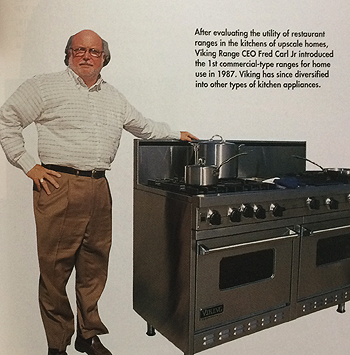
Fred Carl introduced the concept of restaurant ranges in kitchens of upscale homes back in 1987
Fractional ownership alternatives, likewise, were also far from ideal. “We needed at least a half share of an aircraft, and as it turned out a full aircraft, so fractional ownership would have been cost prohibitive for us,” says Carl.
The leased Citation worked out so well that Viking bought a used 970-hr Citation II due to its 8-passenger capacity, efficient operating economics and great safety record. Viking traded up to its current Ultra, acquired from grocery store chain Jitney Jungle, in August 1999. When purchased the Ultra had only logged 430 hrs TT and Viking has been very happy with this productive workhorse now for almost 3 years of operation.
Flight ops evolution “The Ultra is a great aircraft for our missions,” says Edwards. “We fly our executives and employees all over the country and we can bring in guests, celebrity chefs and distributors to Greenwood comfortably and quickly. It gets busy around here! We’ve had 100 hr flying months and we logged 11 landings in 1 day recently in taking 3 different groups to various locations within 1.5 hrs of Greenwood.”
Viking’s Citation Ultra is available to any company employee with a justifiable need. In fact, the CEO is on board the company plane just 23% of its time aloft.
“This is not the CEO’s plane by any stretch of the imagination and I do not hesitate to bump myself on a flight,” says Carl. “We operate our aircraft like a station wagon and it’s a resource available to all employees.”
A Viking flight can be requested through a vp-level employee, with Carl granting final approval. Once a flight is authorized, McCool enters the trip on a Microsoft Outlook flight-scheduling program and informs Edwards. While short notice launches are the exception, Viking can have its aircraft airborne in less than 2 hrs when necessary.
With Viking distributors in most major metropolitan areas, the company plane often fields longer-haul trips out of San Francisco, Las Vegas, New York and Phoenix. The Ultra has also become an indispensable tool in supporting tradeshow travel. “During the recent kitchen and bath convention in Chicago, we were running 2 trips a day out of Greenwood all week long,” recalls Evans.
When Viking undertakes corporate acquisitions, as it did recently in buying Amana’s built-in refrigeration product line, the company plane makes the task more manageable.
“In acquiring the Amana refrigeration line, we were shuttling employees to the corporate location in Houston, as well as to the Amana IW production facilities, over a 6 week period,” recalls VP Public Affairs Dale Persons. “Greenwood to Amana IW is about 1 hr 40 min in the Ultra but it’s a tough all day trip on the airlines.”
Ultra Ops The Citation Ultra’s flights normally operate between FL 390 and 430, at cruise speeds between 410 and 430 kts, with crews operating into runways as short as 4000 feet.
Viking uses the same hiring pilot qualifications as Executive Jet Aviation’s NetJets program – 2500 hrs TT with 500-hrs multi and an ATP. Pilot salaries are industry average and 100% medical coverage is provided along with a dental and 401K plan. Based on year’s service, flight department employees enjoy discounts when purchasing Viking kitchen products.
Pilot input is solicited at Viking for everything from new aircraft acquisitions to flightdeck equipment. “Edwards, Thigpen, Loyd and Dickey have each been in the aviation business over 30 years, they are aviation enthusiasts and they’ve been a great resource,” Carl says.
Viking’s Citation Ultra is well equipped with a 3-tube Honeywell Primus 1000 EFIS flightdeck, GNSXL GPS/FMS, Honeywell TCAS II and Mark V EGPWS with windshear detection. It also has Goodrich Stormscope and a Teledyne MagnaStar digital telephone system.
Factory maintenance Dickey looks after all Citation Ultra inspections, up to the factory’s Phase V level at GWO, while major servicing is dispatched to Cessna in Wichita. Ground service equipment at the Viking hangar is basic and includes a powercart, a hand-operated tug and a few spare parts. Dickey says that product support from Cessna has been superb.
Apart from being an experienced A&P, Dickey is a 12,000 hr TT pilot type-rated in Rockwell Saberliners, 500-series Citations and King Airs. He also serves as a back-up first officer on the Ultra when required.
Future directions For its next corporate aircraft, which may be 12 – 24 months off, Viking would like more range, more cabin space, more baggage capacity and a little more speed.
Viking has looked at the Learjet 45 and 60, Citation Excel and Gulfstream 100, but has not yet found its ideal next-level corporate transport.
“The Gulfstream 100 is the perfect aircraft for us in terms of range, speed and performance-however, the cabin is a little small,” says Carl. “The Citation Excel has just the right cabin but it’s a little light on range and cruise speed. A Falcon 20, retrofitted with new TFE731 engines, is tempting but the fuselages are so old. A Bombardier Continental, Citation Sovereign or Hawker 800 would be more airplane than we need at this time.”
The search continues for the company’s next aircraft. “We need something that does not exist,” Carl says. “Something between the Excel and the Sovereign would suit our needs, as would the Hawker 450.
I’d like to see Dassault take the 3rd engine off the Falcon 50 and re-introduce the airplane as a twin. At this point in the game, I’d have to say that the Lear 45 is probably going to be our best bet due to its range, seating capacity and luggage space.”
Carl says corporate aircraft have allowed Viking Range Corporation to reap the corporate culture and lifestyle advantages of being based in rural Mississippi while remaining connected to the world. He also feels it’s unlikely that advancements in electronic media and virtual reality will replace the need for corporate aircraft anytime soon. “You really need face-to-face contact out in the field to read body language and to get an intuitive sense of people, facilities, corporate cultures and prospective employees. If I had not had the ability to get out in the field with our corporate aircraft, we would not be as successful as we are today and we simply could not have built this company to where it is now.”

